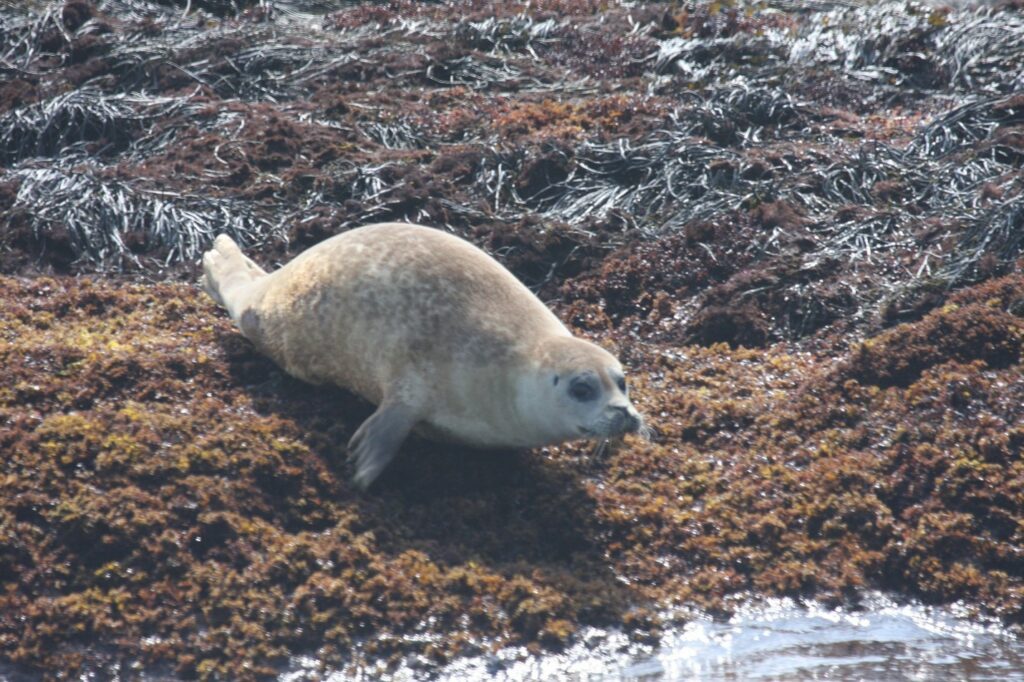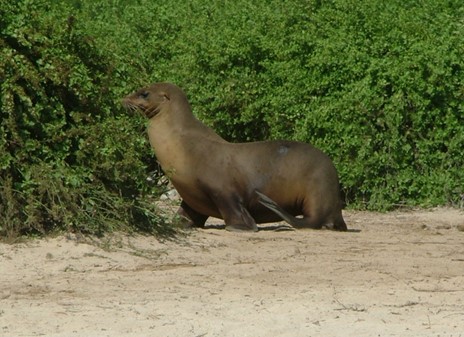by Robert D. Kenney

Three of the previous installments in this Marine Mammals of Rhode Island series have been about seals that occur in our region—harbor seals, harp seals, and gray seals. Gray seals were also the subject of an article in the Fall 2022 issue of Rhode Island Naturalist. There are a couple of questions that readers of the blogs have been asking. One is “Are there sea lions in Rhode Island?” That answer is simple. If I let my “Dr. Smarty-pants” side come through I would just say “No” and leave it at that. But the better answer is “No, because there are no sea lions at all in the North Atlantic, other than perhaps a rare California sea lion that escaped from a zoo or aquarium.”
Another common question is “What is the difference between seals and sea lions?” That gets a little more complicated and gets us into questions of anatomy, evolution, and classification. Seals, sea lions (also fur seals which are very similar), and walruses are close relatives, collectively called pinnipeds (which means “fin-footed”). It is only relatively recently that arguments about the interrelationships of the different pinniped groups have been conclusively settled. It is intuitively obvious that they are physically very similar, but some biologists argued that those similarities were not valid characters to use for understanding their evolutionary origins, since they could represent convergent adaptations to the marine environment. Based on other characters, the argument was that sea lions were more closely related to bears, and seals to mustelids (the family that includes weasels, minks, and otters.) Others argued that all the pinnipeds evolved from a single common ancestor that branched off the carnivore family tree between the bears and the mustelids, which has now been firmly established by both DNA and fossil evidence.

Seals and sea lions belong to different families—Phocidae and Otariidae (literally, “eared”), respectively. The single living walrus species belongs to its own family, Odobenidae. There are some very consistent differences between seals and sea lions (see the accompanying photos):
- Insulation: Mammal coats have two types of hairs—stiffer guard hairs and softer underfur (which is what your dogs and cats shed all over the carpets and furniture when the seasons change). Underfur is the primary layer that traps air and keeps the animal warm. Seals have relatively sparse underfur and are insulated by a thick layer of blubber. Sea lions have thicker underfur and thinner blubber. Fur seals have the thickest underfur, which is their primary difference from sea lions and why every species was hunted to near-extinction.
- External ears: Seals have only an opening on each side of the head behind the eye, while seals have a small external flap at the opening.
- Flippers: Seals have relatively shorter flippers with stout claws, which are covered with fur for their entire lengths. Sea lion flippers are longer and only fur-covered partway down. They are made longer by cartilaginous extensions of the “finger” and “toe” bones, and the claws are smaller and flattened, more like human nails.
- Terrestrial locomotion: The hind flippers of a seal are really only the feet—sticking straight out behind and with the soles facing each other. The leg bones are entirely internal. They cannot rotate the pelvis to bring their hind flippers underneath, and the front flippers are barely long enough to reach the ground, so their movement on land is by undulating along on their bellies like some giant, blubbery caterpillar. The pelvis of a sea lion, on the other hand, can rotate and bring the hind limbs underneath the body, so they can move on land more like other mammals. They are actually capable of a pretty fast gallop.
- Locomotion in the water: Despite their awkward appearance on land, seals are remarkably graceful in the water. They propel themselves by alternate sideways strokes of the hind flippers, which spread out maximally on the power stroke then curl up on the recovery stroke. The big toe and “pinky” toe are the longest, and the middle toe the shortest, creating a broad surface. They use the short front flippers for steering and maneuvering. Sea lions, by contrast, “fly” through the water by flapping the long front flippers and use the hind flippers as rudders.
- Reproduction and life history are dramatically different between the two families, perhaps a topic for another day.
One final question has to do with where the pinnipeds fit in the overall classification of mammals. Many of us of a certain age learned that seals, sea lions, and walruses belong to the mammalian Order Pinnipedia, so you may be wondering why that name is no longer used in the same way. It all has to do with the intricacies of taxonomic rules—the criteria that are used to classify species of animals into larger taxa (singular = taxon). When the only criteria were physical similarities, it made good sense to separate the pinnipeds from all the other carnivores. It is obvious that seals look very different from their carnivore relatives—lions and tigers and bears (oh my!)—which was recognized when German naturalist Johann K.W. Illiger defined the Order Pinnipedia as separate from the Order Carnivora in 1811. That was decades before Darwin’s Origin of Species in 1859, when science began to recognize that similarities often are due to evolution from a common ancestor.
Eventually there came a time when scientists agreed that pinnipeds belonged within the Order Carnivora, and a separate Order Pinnipedia was no longer considered to be valid. A commonly used classification came to divide Carnivora into two Suborders—Pinnipedia and Fissipedia (“cloven-footed,” i.e., separate toes). Again that works on a strictly morphological basis, however the rules of modern taxonomy require that any formally named taxon (a “clade” in current terminology) should (1) include only species that all descend from a common ancestor, and (2) include all the species that share that same ancestor. Fissipedia fails on the second criterion, since the list of all species descending from the most recent ancestor of all “fissipeds” would include pinnipeds.
The accepted classification today splits the Carnivora into two Suborders—Feliformia (cat-like) and Caniformia (dog-like). At some point on the caniform branch after the dog family (wolves, dogs, jackals, foxes) diverged, evolution led to groups like bears, weasels, raccoons, skunks, and pinnipeds. Pinnipedia is a valid clade, since there is strong evidence for evolution from a single ancestral species, although putting a name to its taxonomic rank (somewhere between Infraorder and Superfamily; see the example classification for harbor seals below) gets difficult given the numbers of intermediate taxa that result from modern evolutionary classifications.
Class Mammalia
Order Carnivora
Suborder Caniformia
Arctoidea
Mustelida
Pinnipedimorpha
Pinnipediformes
Pinnipedia
Superfamily Phocoidea
Family Phocidae
Subfamily Phocinae
Tribe Phocini
Genus Phoca
Species Phoca vitulina